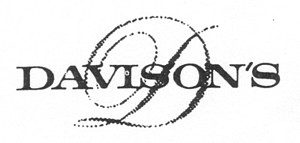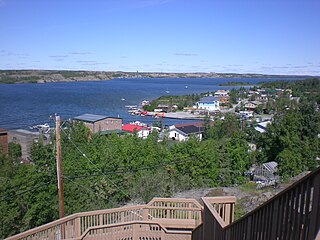Dominion Stores was a national chain of supermarkets in Canada,. The chain was founded in 1919 in Ontario and was later acquired by the Argus Corporation. It was later sold to The Great Atlantic and Pacific Tea Company (A&P), which restricted the chain to the Greater Toronto Area. Stores outside Ontario were converted to the A&P banner or sold to third parties. A&P's Canadian division was later acquired by Metro Inc., which rebranded the remaining Dominion stores to its namesake banner in 2008.
The Ptarmigan and Tom Mine were gold producers located in the Northwest Territories, Canada at Yellowknife. The property was staked by prospectors in 1936 and acquired by Cominco in 1938. The mine first produced between 1941 and 1942 but closed due to wartime restrictions. The old property was demolished in 1969–1970. A new company, Treminco Resources Limited, reopened the workings in 1985 and production from the Tom portal began in 1986 with material being trucked to Giant Mine. The old Ptarmigan mine shaft was dewatered and production began in 1987. A new mill was built at the property and was operational in July 1989. Low gold prices forced the company to close the mines in 1997. Total gold production has been approximately 120,000 troy ounces.
Longs Drugs is an American chain with approximately 40 drugstores throughout the state of Hawaii.

The Wildcat Cafe is a vintage log cabin structure in Yellowknife, Northwest Territories, Canada and represents the mining camp style of early Yellowknife. The structure, which houses a summer restaurant, is located in what was then the central business district of the city. It is a City of Yellowknife Heritage Building, designated in 1992. First opened in 1937 by owners Willie Wylie and Smokey Stout, it is the oldest restaurant in Yellowknife. Subsequent owners were Carl and Dorothy Jensen (1939-1942) and Mah Gow (1942-1951), Yellowknife's first recorded Chinese resident. The cafe closed in 1951 with the illness of Mr. Gow. The building was saved from demolition in the late 1950s when a small group of Yellowknifers fought to have it protected as a heritage site. By 1970 no work had been done to restore the abandoned cabin and it was in poor shape when a new generation of concerned citizens lobbied for its protection. It was soon renovated and reopened as a functional restaurant in 1979. The Old Stope Association, a non-profit heritage society, was responsible for its operation in the 1970s-1980s, and today it is managed by the Wildcat Cafe Advisory Committee. In 1992, the cabin was declared a heritage site as an important old building in Yellowknife and the city took ownership. It is one of Yellowknife's most popular tourist attractions.

Davison's of Atlanta was a department store chain and an Atlanta shopping institution. It was the major competition to Rich's and it took the Macy's name in 1986.
The Penn Fruit Company was a regional grocery chain in the Philadelphia and Baltimore areas that operated from 1927 until 1978. During the firm's history it was regarded as one of the most innovative American supermarket chains. However, the company's innovations often were copied by its bigger rivals who eventually succeeded in causing the chain's demise.

Thrift Drug was a U.S. pharmacy chain founded in 1935 and based in Pittsburgh, Pennsylvania.
Haggen Food & Pharmacy is a grocery retailer in Washington state.
Porteous, Mitchell & Braun Co., or simply Porteous, was a mid-market department store based in Portland, Maine.

River Park Square is a shopping mall and entertainment complex in Spokane, Washington. The shopping center was originally opened in 1974. Following years of decline, the center was redeveloped in 1999 using public and private funds in an effort to revitalize downtown Spokane. The mall, still privately owned by Cowles Company, is anchored by Nordstrom and contains an outpost of AMC Theatres.

Shoppers World Danforth is a hybrid shopping plaza and shopping mall in Toronto, Ontario, Canada. It has 40 stores serving parts of East York, Scarborough and The Beaches, near the Victoria Park subway station. Today a moderately sized suburban plaza, it has a notable place in history as one of the first suburban and one of the first enclosed malls in Canada. It is approximately 342,500 square feet (31,820 m2) in area.
This timeline of Yellowknife history summarises key events in the history of Yellowknife, a city in Northwest Territories, Canada.
Standard Drug Company was a drugstore chain based in Richmond, Virginia. It was founded in 1919 by Samuel and Leo Rosenthal, who were graduates of the MCV School of Pharmacy. The first store opened on Main Street in Downtown Richmond as a pharmacy only. In 1921 the Rosenthals acquired a large building at the corner of First and Broad streets that became the anchor store to the first discount drug chain in America. It thrived for decades, expanding throughout Virginia into Washington, D.C., and its Maryland suburbs.
The Lane Drug Company of Ohio, was a discount drugstore chain in the United States that was originally based in Toledo, Ohio. On 10 April 1989, the chain was acquired by Rite Aid Corporation of Harrisburg, Pennsylvania, and currently operates as a division of Rite Aid.

The Bank of Toronto is a historic cabin located in Old Town, Yellowknife, Northwest Territories, Canada. The log cabin was constructed in 1939 by John Stakson an expert log builder in the commercial district of the Yellowknife community for use as a residence. In October 1944, the Bank of Toronto purchased the cabin and opened a new bank for the community, joining the Bank of Commerce. The bank arrived in Yellowknife in response to new financial activity brought about by the intersection of gold in shear zones at Giant Mine and the resulting staking spree around the region. As the gold rush ended, the volume of business was insufficient to keep the bank profitable, and the Bank of Toronto closed this branch in August 1951.

The Hudson's Bay Company began a trading post in Yellowknife, Northwest Territories, Canada in 1938 at the height of the first gold rush in the region. Fire destroyed the original building in January 1945, and the HBC rebuilt and reopened this expanded trading post store and warehouse in November 1945. It served the Old Town waterfront of Yellowknife for several years. The post was primarily designed for prospector's bush orders during the gold boom years. With the opening of a modern downtown department store in 1947, the Old Town post catered almost exclusively to bush orders, fur trappers, commercial fishers, and prospector supplies. The store closed in 1960 when all HBC operations were centralized to the downtown location. Thereafter, the building was used only as a warehouse for HBC retail operations. The Bay retail stores were rebranded as Northern Stores Inc in 1987 and the warehouse was sold to Les Rocher who has owned it ever since.

The first building used as a school in Yellowknife, Northwest Territories, Canada, is currently located on Franklin (50th) Avenue at the south end of New Town, the city's downtown section. It is a small log cabin dating to the mid-1930s. It was designated a City of Yellowknife Heritage Site in 1998, and listed on the Canadian Register of Historic Places in 2004.

Back Bay Cemetery, the original cemetery in Yellowknife, Northwest Territories, Canada, is located on Back Bay, a section of Yellowknife Bay on Great Slave Lake. The first recorded burial here was on September 27, 1938 following the death of Art McIntyre who committed suicide because of his fear of working underground. Between 1938 and 1946, when the cemetery was closed and relocated, over 40 people were buried here. Continual erosion of a nearby creek bank has damaged and exposed many graves. The site is designated a City of Yellowknife Heritage Site. By late 2014, the site had fallen into even greater disrepair and was in need of proper maintenance.













